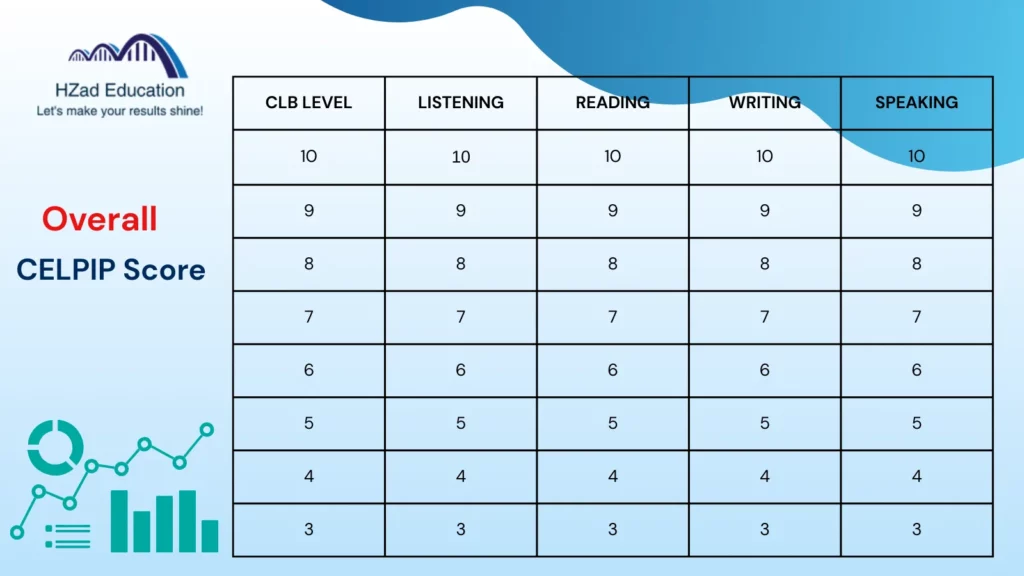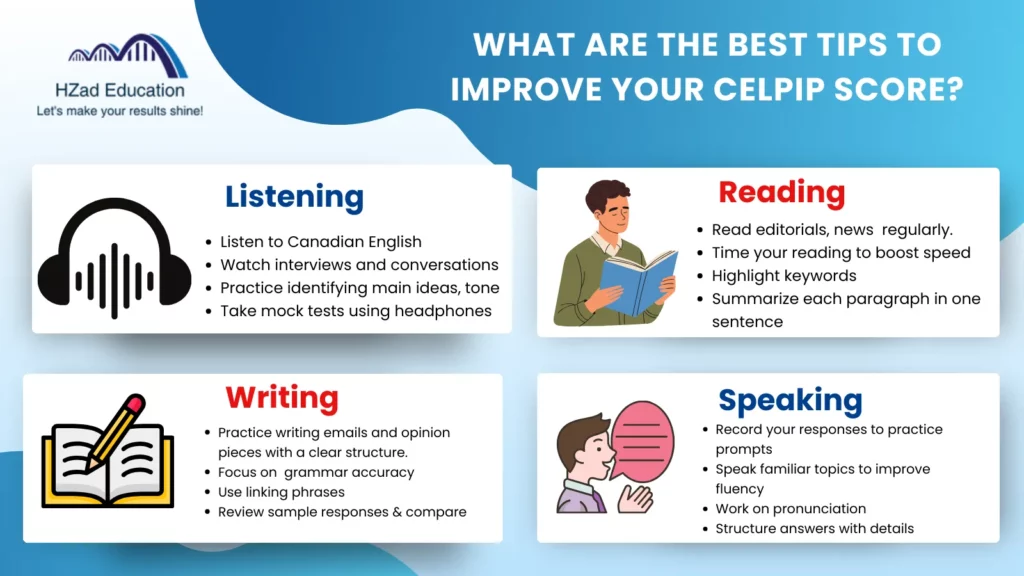What is the CELPIP Score Chart, and How Can It Help You?
The CELPIP score chart is a visual scale that translates CELPIP scores to their equivalent Canadian Language Benchmark (CLB) levels. It helps candidates understand how their Listening, Reading, Writing, and Speaking performance maps to the language standards required by Immigration, Refugees and Citizenship Canada (IRCC) for PR and citizenship applications.
Using the score chart, test takers can identify their language strengths and weaknesses, verify whether they meet minimum CLB requirements for immigration, and develop a focused study plan to improve section-wise performance.
Understanding this chart is essential for anyone trying to qualify through Canada’s language-based selection criteria.
How Does the CELPIP Score Comparison Chart Help You?
The CELPIP score comparison chart helps participants and educators understand different English language levels by evaluating CELPIP scores against Canadian Language Benchmark (CLB) levels and the equivalent IELTS band.
Understanding the CELPIP score comparison chart enables individuals to align the CELPIP score with official benchmarks. This analysis helps identify whether one meets language requirements for immigration and citizen applications in Canada, such as Express Entry and Provincial Nominee Programs.
Below is the table showcasing the CELPIP score and CLB level equivalencies:
| CELPIP Score | CLB Level | Language Proficiency Description |
| 12 | CLB 12 | Expert proficiency in workplace and community contexts |
| 11 | CLB 11 | Advanced professional fluency and comprehension |
| 10 | CLB 10 | High proficiency in demanding professional tasks |
| 9 | CLB 9 | Effective proficiency in workplace communication |
| 8 | CLB 8 | Good proficiency for most daily life activities |
| 7 | CLB 7 | Adequate proficiency for basic work and community interactions |
| 6 | CLB 6 | Developing proficiency for familiar situations |
| 5 | CLB 5 | Acquiring basic language skills for everyday use |
| 4 | CLB 4 | Adequate proficiency in daily life activities |
| 3 | CLB 3 | Some proficiency in communication |
| 2 | CLB 1, 2 | Limited ability to convey immediate needs |
| 1 | – | Insufficient information to access |
| 0 | – | Insufficient information to access |
Likewise, here is the table highlighting the CELPIP and IELTS score equivalencies:
| CELPIP Score | IELTS Band (Approx.) | CLB Level |
| 12 | 9.0 | CLB 12 |
| 11 | 8.5 | CLB 11 |
| 10 | 8.0 | CLB 10 |
| 10 | 7.5 | CLB 10 |
| 9 | 7.0 | CLB 9 |
| 8 | 6.5 | CLB 8 |
| 7 | 6.0 | CLB 7 |
| 6 | 5.5 | CLB 6 |
| 6 | 5.0 | CLB 6 |
| 5 | 4.5 | CLB 5 |
| 4 | 4.0 | CLB 4 |
Once candidates can analyze the chart, they can assess their English proficiency levels and identify their strengths and weaknesses. This helps them work on the required listening, reading, speaking, or writing skills and improve their performance.
Below are 5 main points outlining the benefits of using the CELPIP score comparison chart:
- Understand language proficiency level through CLB equivalency.
- Compare CELPIP scores with IELTS, helping in test selection.
- Identify weaknesses and plan targeted preparation.
- Check eligibility for Canada PR and other immigration programs.
- Monitor progress in individual modules (Listening, Reading, Writing, Speaking).
How Do You Read the CELPIP Score Chart?
You can read the CELPIP score chart by understanding the scoring range of each test section, including listening, reading, writing, and speaking, that corresponds directly to a CLB level. This chart serves as a structured framework that allows test takers to gauge their English language proficiency in a way that aligns with Canadian immigration and citizenship standards.
Each section is scaled from 1 to 12, with higher numbers indicating higher proficiency. Advanced proficiency in the English language shows an individual’s expertise in workplace communication and professional interactions. These scores are calculated based on content coherence, vocabulary control, task fulfillment, readability, listenability, and clarity, reflecting the test taker’s ability to comprehend, express, and interact in English.
Similarly, the CELPIP score is excellent for assessing the current proficiency level to verify whether it meets the language requirements for Canadian Permanent Residency (PR) or other immigration programs. For instance, most federal immigration streams require a minimum CLB 7, equivalent to a CELPIP score of 7 in all four components.
The CELPIP score chart also guides individuals in measuring performance, clarifying the meaning of each level, and understanding the gap between their current proficiency and immigration requirements. By reading the score chart accurately, test takers can prepare more effectively, focus on weaker areas, and work eagerly towards securing the required CLB level for a successful application.
Listening Score Chart
The Listening section of CELPIP evaluates the ability to comprehend spoken English in conversations, announcements, and discussions. Test takers listen to passages and answer questions within 46–55 minutes.
| CELPIP Score | CLB Level | Listening Proficiency Description |
| 12 | CLB 12 | Fully understands complex speech, idioms, and nuance |
| 10–11 | CLB 10–11 | Accurately follows detailed instructions and presentations |
| 7–9 | CLB 7–9 | Understands factual content and main ideas in most contexts |
| 4–6 | CLB 4–6 | Understands simple dialogues and daily conversations |
| 1–3 | CLB 1–3 | Limited comprehension of slow and basic spoken English |
Reading Score Chart
The Reading section tests comprehension of written English through a range of texts, including emails, articles, and advertisements. Participants read passages and answer questions within 43–56 minutes.
| CELPIP Score | CLB Level | Reading Proficiency Description |
| 12 | CLB 12 | Interprets complex text and abstracts key information |
| 10–11 | CLB 10–11 | Analyzes professional documents and policy text |
| 7–9 | CLB 7–9 | Reads and understands everyday written materials |
| 4–6 | CLB 4–6 | Grasps simple sentence structures and common vocabulary |
| 1–3 | CLB 1–3 | Recognizes basic words and sentence patterns |
Speaking Score Chart
The Speaking section assesses the ability to express ideas, opinions, and information verbally. Candidates reply to on-screen prompts verbally within 15 minutes in both General and General LS formats.
| CELPIP Score | CLB Level | Speaking Proficiency Description |
| 12 | CLB 12 | Expresses complex ideas fluently with natural phrasing |
| 10–11 | CLB 10–11 | Minor errors; communicates clearly and confidently |
| 7–9 | CLB 7–9 | Can respond to familiar questions with structured language |
| 4–6 | CLB 4–6 | Limited fluency; basic vocabulary and simple sentence structure |
| 1–3 | CLB 1–3 | Hesitant speech with frequent errors and repetition |
Writing Score Chart
The Writing section evaluates the test taker’s ability to communicate ideas in written English. Individuals must respond to questions with written answers in 53 minutes.
| CELPIP Score | CLB Level | Writing Proficiency Description |
| 12 | CLB 12 | Writes persuasive, detailed responses with strong coherence |
| 10–11 | CLB 10–11 | Uses varied vocabulary with minimal grammar issues |
| 7–9 | CLB 7–9 | Communicates clearly on familiar topics with acceptable structure |
| 4–6 | CLB 4–6 | Basic writing with grammar mistakes; limited vocabulary |
| 1–3 | CLB 1–3 | Incomplete or disorganized writing with frequent errors |
What is the Minimum CELPIP Passing Score for Canada PR?
*As of the time of the blog upload.
For Canada PR, the minimum CELPIP passing score is 5 in each ability (speaking, listening, reading, and writing).
Individuals hoping for Canada PR via Express Entry have different criteria under the three programs.
- Canadian Experience Class
-
- TEER 0 or 1: CELPIP score 7 in each ability
- TEER 2 or 3: CELPIP score 5 in each ability
- Federal Skilled Worker Program
For this program, individuals need at least 7 in all test sections in CELPIP General for First official language speakers. A higher CELPIP score earns you more points, which helps increase your CRS score and solidify your application.
| CELPIP Level | Points Per Ability | Total Possible Points |
| 7 CELPIP-G | 4 | 16 |
| 8 CELPIP-G | 5 | 20 |
| 9 and above CELPIP-G | 6 | 24 |
If you also qualify as a Second official language speaker, you get an extra 4 points for securing a minimum of 5 CELPIP-G scores.
- Federal Skilled Trades Program
Under this program, applicants must have a CELPIP score of 4 in reading and writing and a CELPIP score of 5 in speaking and listening.
What is the Difference Between the CELPIP General and General LS Score Charts?
The main difference between the CELPIP General and General LS score charts lies in the number of test sections accessed, serving diverse immigration purposes. The CELPIP General evaluates all four skills (Listening, Reading, Writing, and Speaking), and the CELPIP General LS assesses two sections (Listening and Speaking).
Below is a table highlighting significant differences between the CELPIP General and the CELPIP General LS score charts.
| Feature | CELPIP General | CELPIP General LS |
| Skills Tested | Listening, Reading, Writing, Speaking | Listening, Speaking |
| Primary Use | Permanent Residency (PR), Express Entry | Canadian Citizenship |
| CLB Level Mapping | CLB 1 to 12 for all four modules | CLB 1 to 12 for Listening and Speaking only |
| Test Duration | Under 3 hours | About 1 hour and 10 minutes |
| Accepted By | IRCC (PR programs like FSWP, CEC, FSTP) | IRCC (Citizenship applications) |
| Preparation Requirement | More comprehensive (requires grammar, writing structure, and reading comprehension) | Focused on oral communication skills |
| Recommended For | Skilled workers, economic class immigrants | Citizenship applicants requiring to prove speaking and listening proficiency |
What Are the Best Tips to Improve Your CELPIP Score?
The best way to improve your CELPIP score is to target each test section with focused practice strategies that enhance proficiency, task performance, and confidence. Whether you are aiming for immigration or citizenship, building strength in listening, reading, writing, and speaking will improve your overall performance.
Below are the actionable CELPIP preparation tips by section.
Listening:
- Listen to Canadian English podcasts and radio programs daily.
- Watch interviews and conversations to build comprehension speed.
- Practice identifying main ideas, tone, and speaker intent.
- Take mock tests using headphones to simulate test conditions.
Reading:
- Read editorials, news articles, and workplace documents regularly.
- Time your reading to increase speed without losing accuracy.
- Highlight keywords and infer meaning from context.
- Summarize each paragraph in one sentence to improve retention.
Writing:
- Practice writing emails and opinion pieces with a clear structure.
- Focus on coherence, grammar accuracy, and vocabulary variety.
- Use linking phrases (e.g., “In contrast,” “Therefore,” “For example”).
- Review sample responses and compare them to yours for improvement.
Speaking:
- Record your responses to practice prompts and evaluate clarity.
- Speak about familiar topics to improve fluency and natural rhythm.
- Work on pronunciation by mimicking native speakers.
- Structure answers with an introduction, details, and a conclusion.
What Are Common CELPIP Test FAQs?
How is the CELPIP Score Calculated?
The CELPIP score is calculated by taking the average individual scores from the four components: Listening, Reading, Writing, and Speaking. The Listening and Reading sections are machine-scored, while the Writing and Speaking responses are rated by trained human raters using standardized performance benchmarks that align with Canadian Language Benchmarks (CLB).
What is the Highest Possible CELPIP Score?
The highest possible CELPIP score is 12 in each section, corresponding to CLB level 12. A score of 12 indicates highly effective English proficiency suitable for complex professional and community communication tasks in Canada.
How is CELPIP Different from IELTS?
CELPIP is a Canadian-based, fully computer-delivered English language test, while IELTS is an internationally recognized test in paper-based and computer-based formats. CELPIP uses Canadian English and evaluates all four skills, Listening, Reading, Writing, and Speaking, within a single sitting.
IELTS offers Academic and General Training modules ranging from 1 to 9 band scale, whereas CELPIP offers General and General LS versions on a 1–12 scale.
How Should I Prepare for CELPIP?
To prepare for CELPIP, use official CELPIP practice materials, focus on timed mock tests, and strengthen each skill area individually. Some of the recommended strategies for scoring higher points in the CELPIP test include:
- Listening to Canadian English audio content.
- Reading various informational texts to build comprehension.
- Practicing structured writing tasks like emails and responses.
- Recording speaking answers to simulate actual test conditions.
You can also enroll in HZad Education’s CELPIP 10 Courses and get expert guidance for securing high CELPIP scores.




